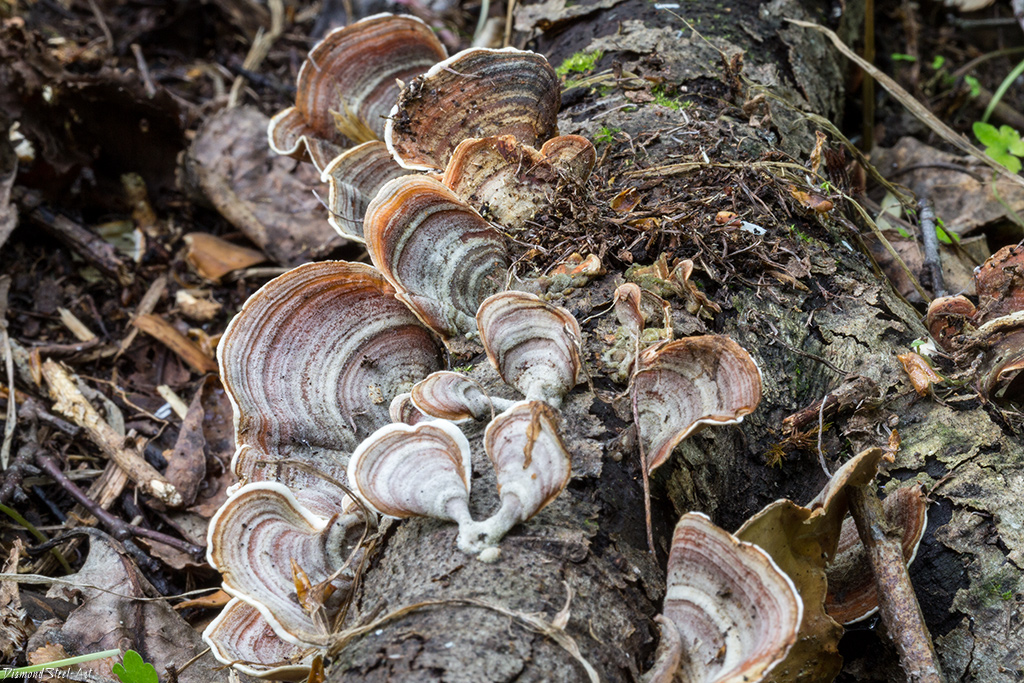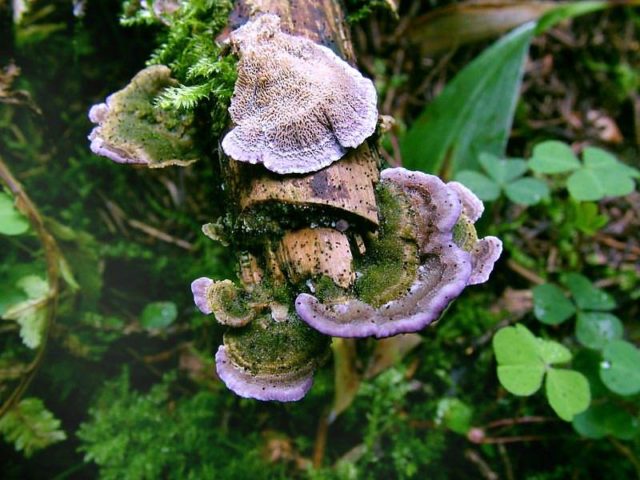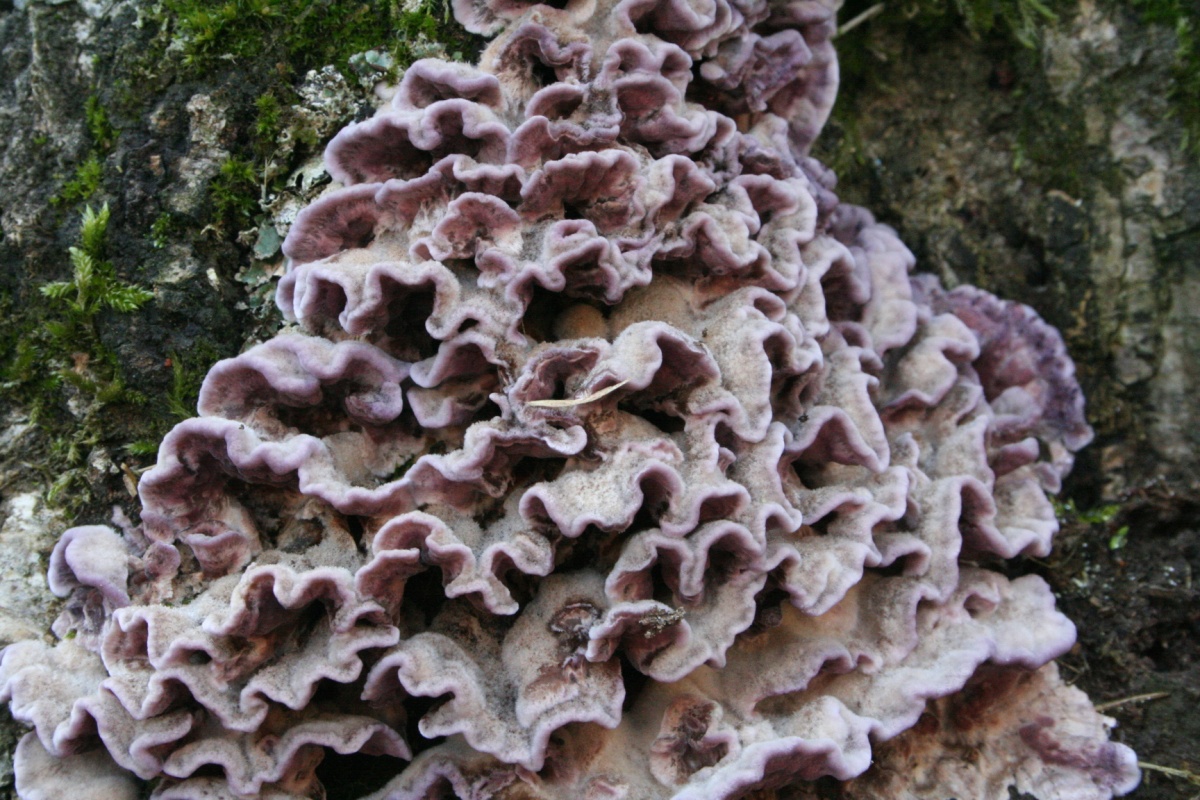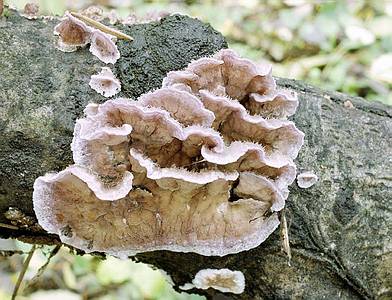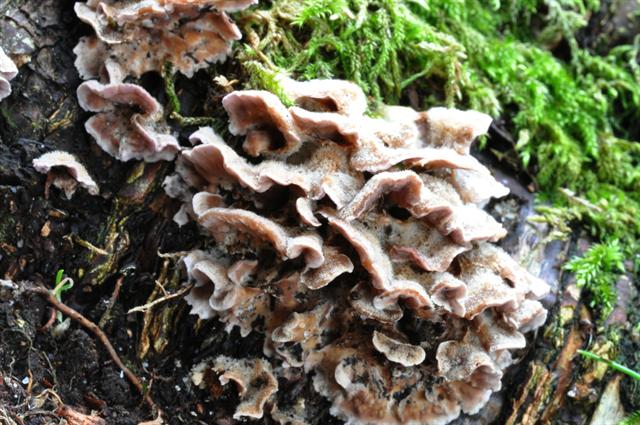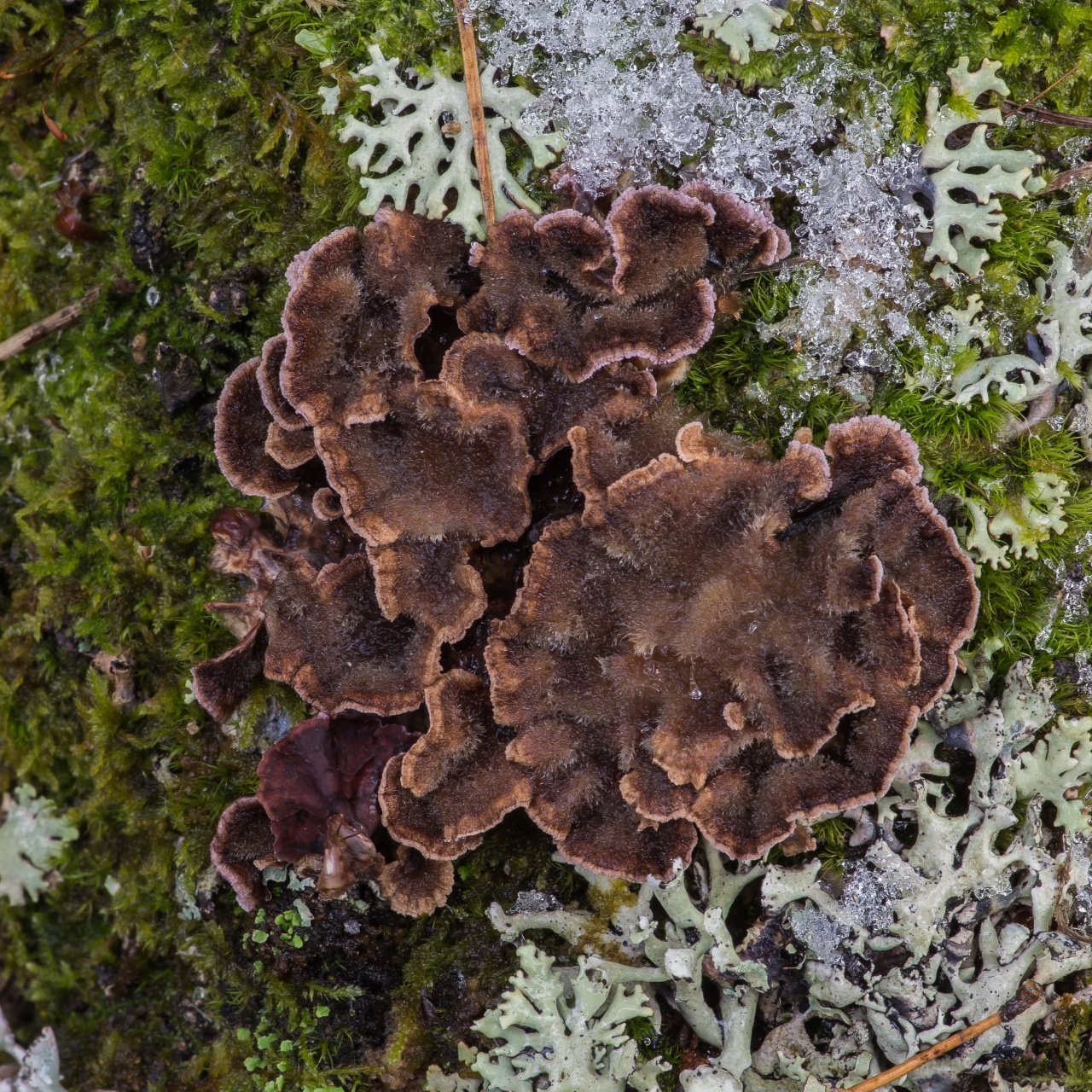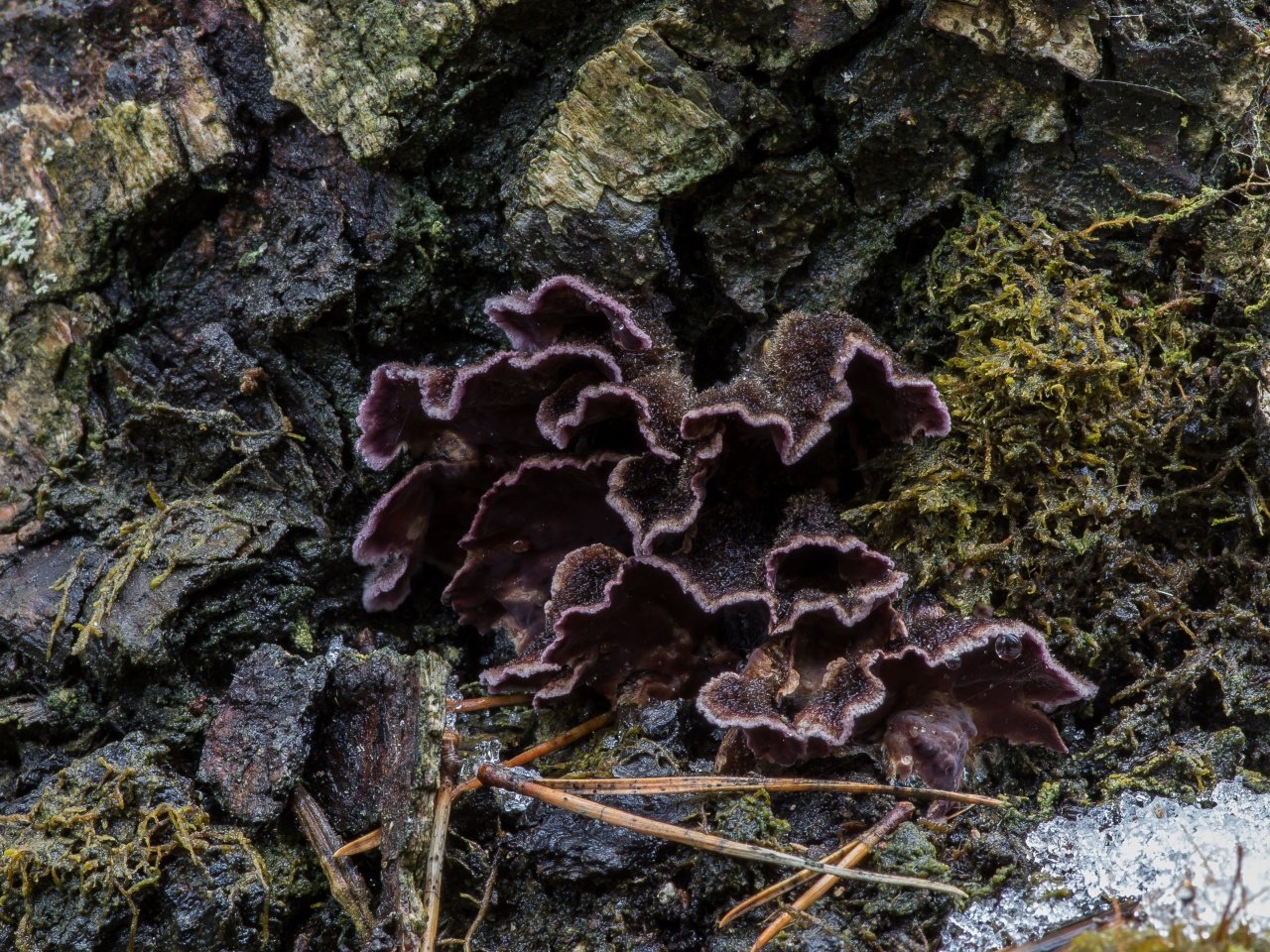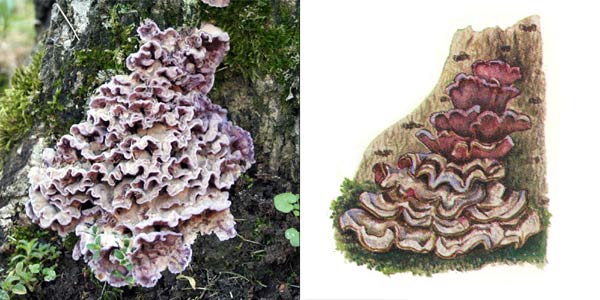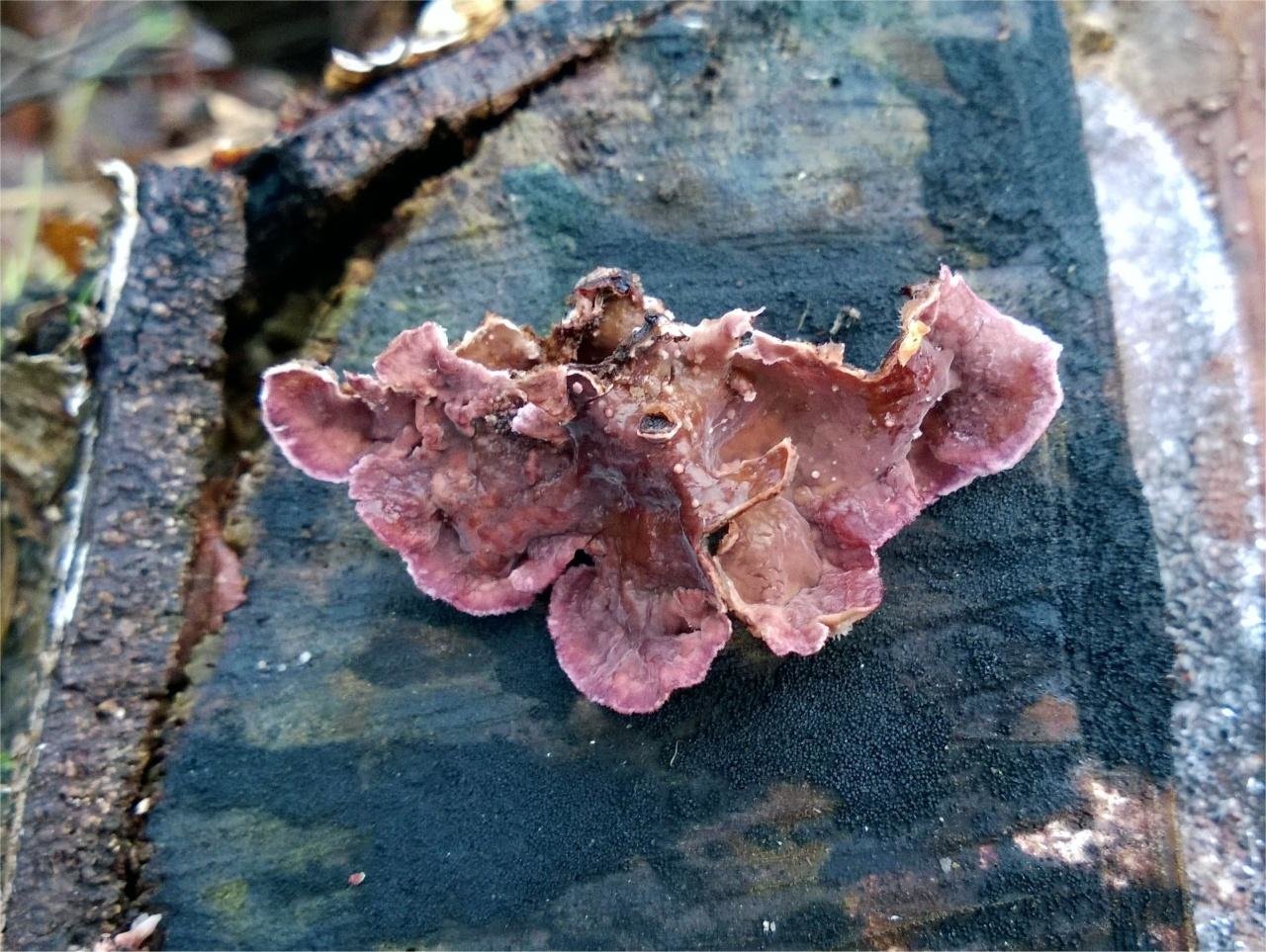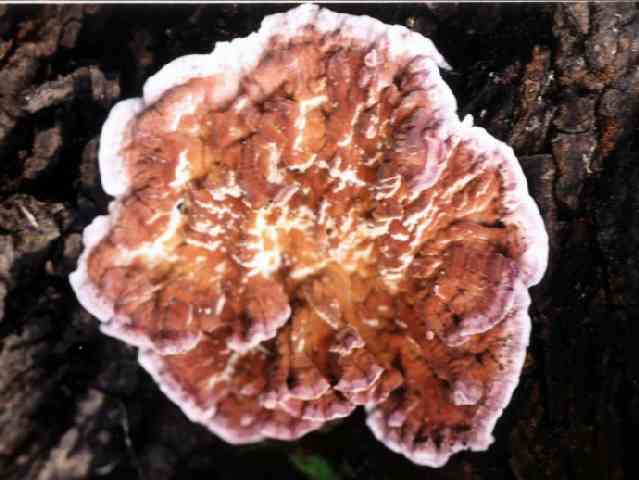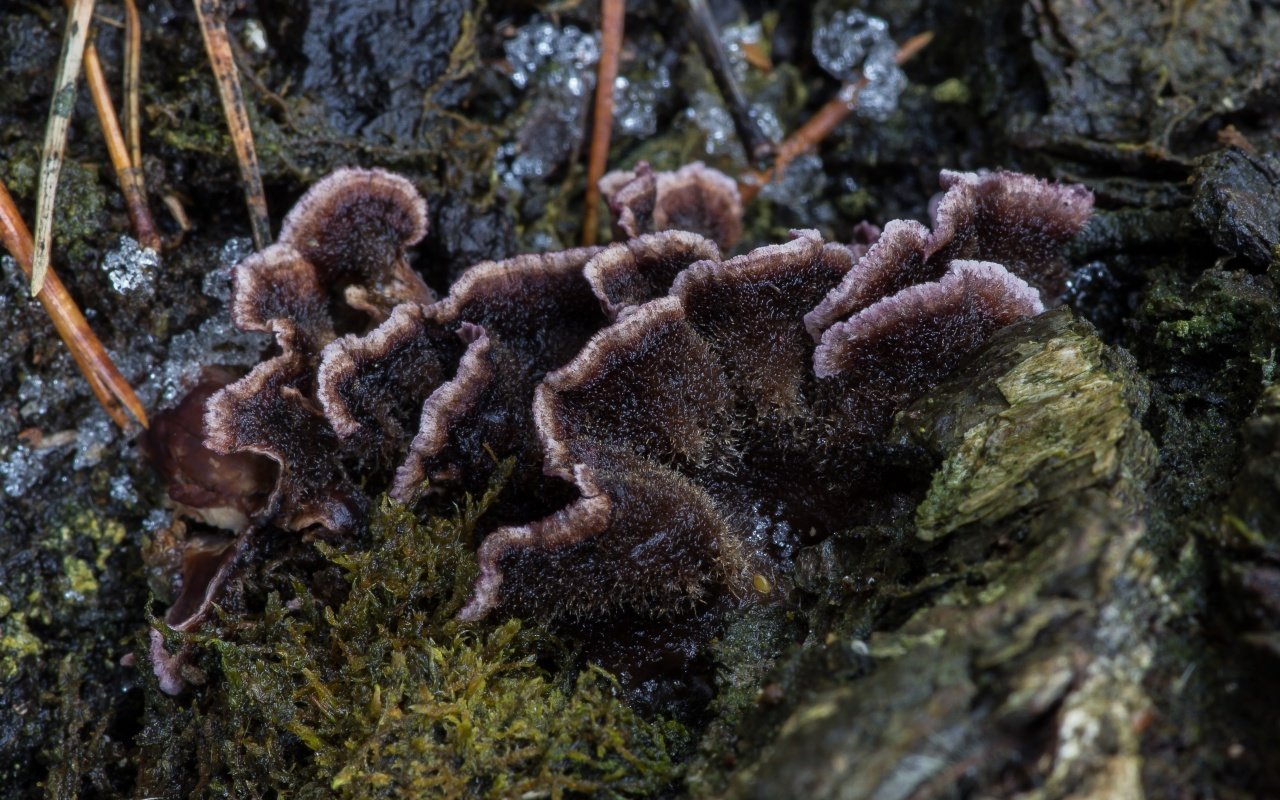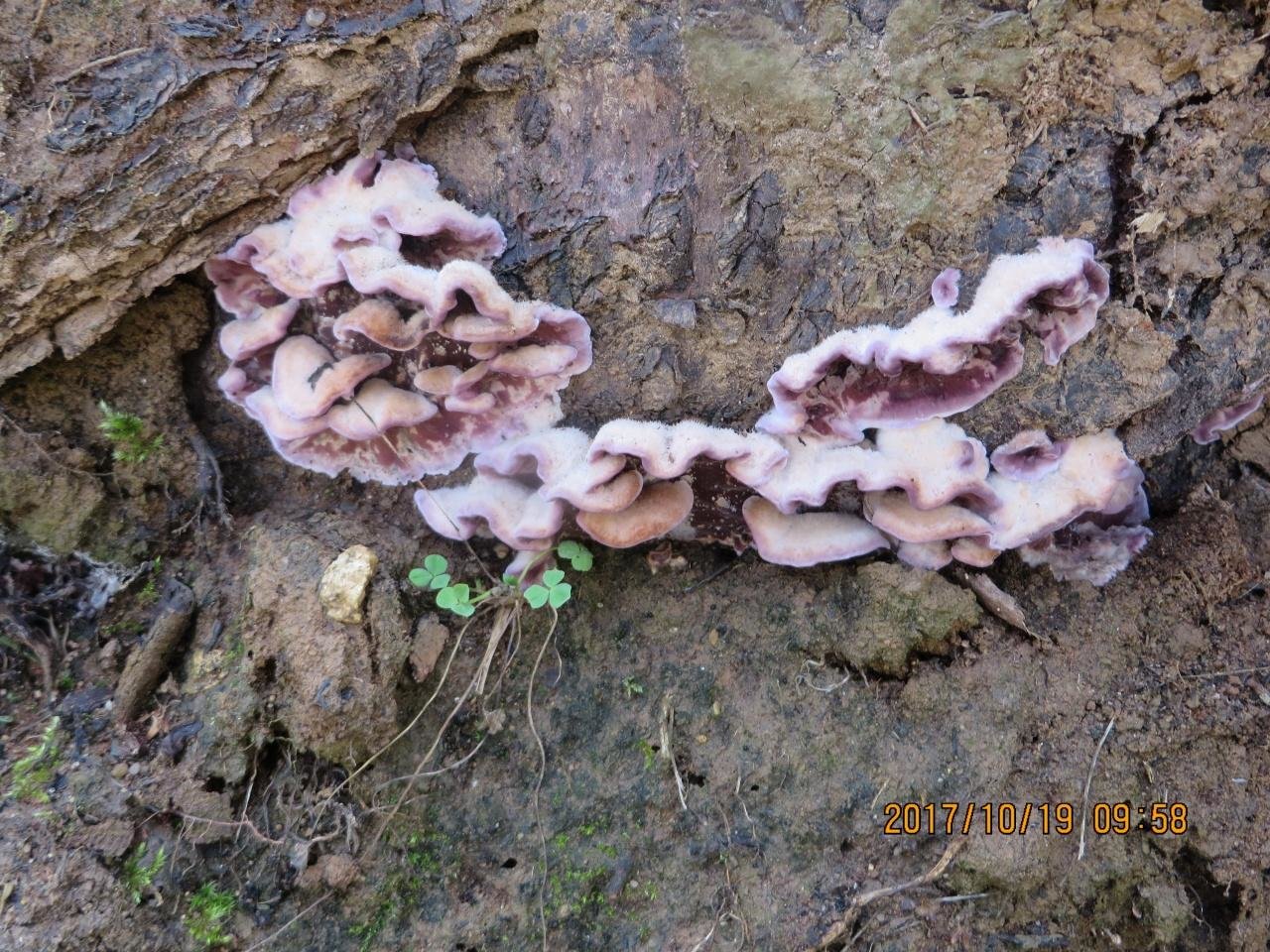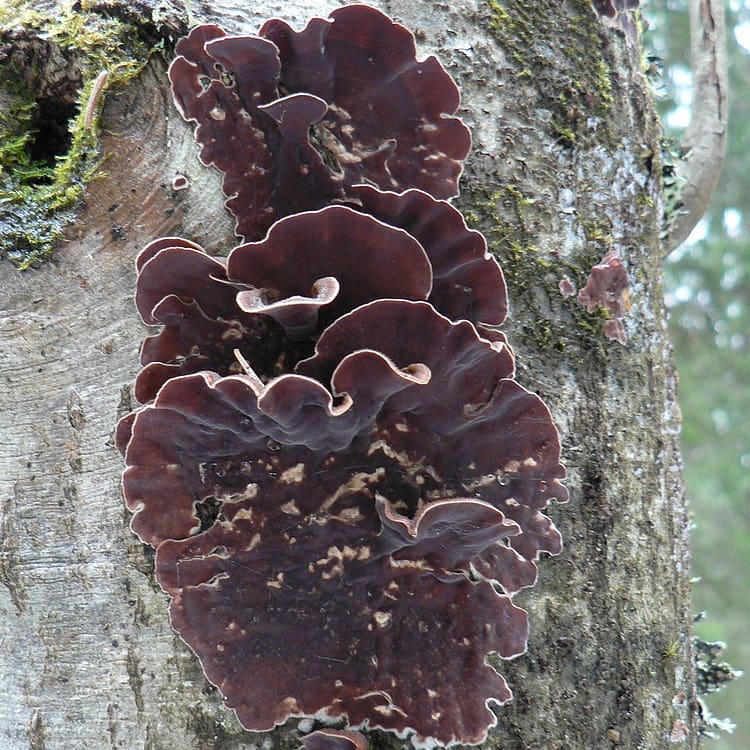chondrostereum purpureum: basic information about the pesticide
Description: A naturally occurring mushroom that is used to prevent the overgrowth of unwanted trees in temperate forests
Registered year: discovered circa 1998
Placement of pesticides on the market (directive 91/414 / EEC), status:
| Status | Not described |
| Rapporteur / co-rapporteur dossier | Not determined |
| Power on date expires | Not determined |
Approved for use (V) or known (#) in the following European countries:
Basic information:
| Pesticide type | Herbicide, Mycoherbicide |
| Chemical structure group | Biopesticide |
| The nature of the action | Fungi invade fresh wounds in the wood. It then develops within a tree, spreading to the vascular system, leading to decay and rotting wood |
| CAS registration number | — |
| CF code (Enzyme Code) | — |
| International Joint Pesticide Analytical Council (CIPAC) code | — |
| United States Environmental Protection Agency (US EPA) chemical code | — |
| Chemical formula | — |
| SMILES | — |
| International Chemical Identifier (InChI) | — |
| Structural formula | No |
| Molecular weight (g / mol) | — |
| Chemical Translation | Chondrostereum purpureum pouzar |
| Other information | — |
| Herbicide resistance by HRAC | Not determined |
| IRAC insecticide resistance | Not determined |
| FRAC Fungicide Resistance | Not determined |
| The physical state | — |
Release:
| Pesticide manufacturers |
|
| Commercial names of preparations containing ai. | — |
| Associated with this substance: | — |
| Pesticide Risk Assessment for Local Ecology (England) | No UK approval for use |
| Preparative form and features of application | Supplied as a suspension of fungal spores in water and used as a spray or coloring treatment applied directly to the fresh tenderloin. |
Mycoherbicide
Chondrostereum purpureum is commercially available as a method of combatting forest weed trees (sic) such as aspens, beech, birches, maples, pin cherry and poplars and other species. The fungus is applied directly to the weed trees in a nutrient paste which can be stored and handled conveniently.
The first regulatory approval was granted in 2001 to Myco-Forestis Corporation and targetted species “including birch, pin-cherry, poplar / aspen, red maple, sugar maple, and speckled alder in the Boreal and Mixed forest regions of Canada, east of the Rocky Mountains ". It had not been reported as of 2001 to cause any diseases in coniferous tree species.
According to a 2007 regulatory decision of the Canadian Pest Management Regulatory Agency, the use of this control method in paste form on Sitka spruce and red alder will only have a limited impact on non-target trees since the fungal spores are ubiquitous anyway and healthy trees are resistant to attack.
chondrostereum purpureum: ecotoxicity
| Index | Meaning | Source / Qualitative indicators / Other information | Explanation | |
| Bioconcentration factor | BCF: | — | — | — |
| CT50 (days): | — | — | ||
| Bioaccumulation potential | — | — | — | |
| Mammals - Acute oral LD50 (mg / kg) | — | — | — | |
| Mammals - Short Period Food NOEL | (mg / kg): | — | — | — |
| (ppm food): | — | — | ||
| Birds - Acute LD50 (mg / kg) | — | L3 Safe | — | |
| Birds - Acute toxicity (CK50 / LD50) | — | — | — | |
| Fish - Acute 96 hour CK50 (mg / l) | — | L3 Safe | — | |
| Fish - Chronic 21 days NOEC (mg / L) | — | — | — | |
| Aquatic invertebrates - Acute 48 hour EC50 (mg / L) | — | L3 Safe | — | |
| Aquatic invertebrates - Chronic 21 days NOEC (mg / L) | — | — | — | |
| Aquatic Crustaceans - Acute 96 Hour CK50 (mg / L) | — | — | — | |
| Bottom microorganisms - Acute 96 h CK50 (mg / l) | — | — | — | |
| Bottom microorganisms - Chronic 28 days NOEC, static, Water (mg / l) | — | — | — | |
| Bottom microorganisms - Chronic 28 day NOEC, Sedimentary rock (mg / kg) | — | — | — | |
| Aquatic plants - Acute 7 days EC50, biomass (mg / l) | — | — | — | |
| Algae - Acute 72 hour EC50, growth (mg / l) | — | — | — | |
| Algae - Chronic 96 Hour NOEC Growth (mg / L) | — | — | — | |
| Bees - Acute 48 hour LD50 (μg / individual) | — | — | — | |
| Soil Worms - Acute 14-day CK50 (mg / kg) | — | — | — | |
| Soil Worms - Chronic 14-day Maximum Inactive Substance Concentration, Reproduction (mg / kg) | — | — | — | |
| Other soil macro-organisms, such as Leopards | LR50 / EC50 / NOEC / Action (%) | — | — | — |
| Other Arthropods (1) | LR50 (g / ha): | — | — | — |
| Action (%): | — | — | — | |
| Other Arthropods (2) | LR50 (g / ha): | — | — | — |
| Action (%): | — | — | — | |
| Soil microorganisms | — | — | — | |
| Available data on the mesoworld (mesocosm) | NOEAEC mg / l: | — | — | — |
| NOEAEC mg / l: | — | — | — |
Stereum purple: photo and description
| Name: | Stereum magenta |
| Latin name: | Chondrostereum purpureum |
| Type of: | Inedible |
| Synonyms: | Chondorostereum purple, Stereum purple-violet |
| Specifications: |
|
| Systematics: |
|
Stereum purple is an inedible species of the Cifell family. The fungus grows as a saprotroph on stumps and dry wood, and as a parasite on deciduous and fruit trees. It often settles on the walls of wooden buildings, leading to rapid decay and destruction. To recognize a mushroom, you need to study its description and view a photo.
Where the stereum purple grows
The variety begins bearing fruit from September to mid-December. It can be seen on dry wood, tree stumps, and living trunks and roots of deciduous trees. It grows in numerous groups, less often as single specimens. When horticultural crops are damaged, it causes snow-white rot and milky sheen disease. The disease can be recognized by discolored foliage, which eventually becomes shiny with a pronounced silvery sheen. Without treatment, after 2 years, the branches of the affected tree throw off the foliage and dry out.
What does stereo magenta look like?
Purple stereum is a parasitic species with a small disc-shaped fruiting body, about 2-3 cm in size. Felt-fleecy, cream or light brown variety grows on wood in the form of small spots at a young age. With age, the fruit body grows and becomes fan-shaped with wavy slightly drooping edges.

After frost, the fruit body fades and becomes grayish-brown in color with light edges. Due to this color, the parasitic fungus is difficult to recognize, since in appearance it is similar to other types of stereums.
The smooth, slightly wrinkled hymenophore is colored dark purple with a light whitish purple border. Propagated by colorless, cylindrical spores, which are located in the coffee spore powder.
The pulp is thin and tough, with a pleasant spicy aroma. In the section, the upper layer is colored gray-brown, the lower one is pale cream.
Is it possible to eat the stereum magenta
Stereum purple is an inedible mushroom. Due to the lack of taste, dense, tough pulp and nutritional value, the variety is not used in cooking.
Similar species
This variety has similar counterparts. These include:
- Fir trichaptum. The fungus grows on dry coniferous wood in multi-layered layers. The small fruiting body is light brown. The surface is felted, pubescent, after rains it becomes covered with algae and acquires a greenish tint. The underside is bright purple, becoming chocolatey and elongated with age.
- Coarse-haired, grows on stumps and dead wood, rarely affects live, weakened deciduous trees. The species is perennial, has a fan-shaped fruit body with unfolded edges. The surface is smooth, painted lemon brown with a greenish tint. Prefers to grow in groups, forming long, wrinkled ribbons. Due to the lack of taste, the species is not used in cooking.
- Felt, distinguished by its larger size, velvety surface and reddish-brown color. Grows on stumps, dry, on diseased, affected trees. The species is inedible, as it has a tough pulp.
Application
Since this variety infects dry wood and causes a fungal disease on apple trees, pears and other stone fruits, both gardeners and workers in woodworking factories struggle with it. And due to the lack of taste and tough pulp, it has no nutritional value and is not used for cooking.
Conclusion
The purple stereum is an inedible member of the Cifell family.The fungus often infects dead wood, treated wood, live fruit trees and the walls of wooden houses. If you do not start a timely fight, the fungus can quickly destroy buildings and reduce the yield of stone fruit trees.
Characteristics
It is a pathogen of various deciduous trees including species of Acer, Aesculus, Alnus, Betula, Crataegus, Fagus, Larix, Malus, Ostrya, Picea, Populus, Prunus, Salix, and Sorbus.
After starting as just a crust on the wood, the fruiting structure develops undulating intergrowing brackets up to about 3 cm broad, which have a tough rubbery texture. The edges and fertile lower surfaces show a fairly vivid violet color while the fungus is growing, and the upper surfaces have a gray aspect (sometimes with zonation) and are covered with whitish hairs. After a week or two the fructification dries out, becomes brittle, and turns a drab brown or beige. Infected wood can be recognized because it is stained a darker tint.
The spores are rounded cylinders approximately 5-8 µm x 3-4 µm in size. The hyphal structure is monomitic with clamp connections.
It is often found on old stumps and dead wood, but can also be a serious parasite of living trees. As well as plum trees it attacks many other broad-leafed species (other Prunus, apple, pear, willow, poplar, maple, hornbeam, plane, oak, elm, lilac, and many others). Occasionally it also infects conifers (fir, spruce, Thuja, ...). Geographically it is roughly speaking just as widespread as its hosts - it is common in woods, orchards and tree plantations in temperate climates.
References
- ^ Entry "Silver-leaf Fungus" in Phillips, Roger (1981) "Mushrooms and other fungi of Great Britain & Europe" published by Pan Books Ltd., Cavaye Place, London SW10 9PG (ref. CN1794)
- ^ Compatibility of the Open Government License - Canada with Wikimedia projects
- Marcel Bon: The Mushrooms and Toadstools of Britain and North-Western Europe Hodder & Stoughton ISBN 0-340-39935-X.
- Courtecuisse, R. & Duhem, B. (1994) "Guide des champignons de France et d'Europe" Delachaux et Niestlé ISBN 2-603-00953-2, also available in Russian.
- ^
- Strouts, R. G., and T. G. Winter. 2000. Diagnosis of ill-health in trees... Norwich: Stationery Office Books. ISBN 0-11-753545-1
Características
Después de comenzar solo como una costra en la corteza, el cuerpo frutal desarrolla una estructura ondulante de unos 3 cm de ancho, que tiene una estructura gomosa dura. Los bordes y las superficies inferiores fértiles, muestran un vívido color púrpura, mientras el hongo está creciendo y la superficie superior es de color gris.
Después de una semana o dos, el cuerpo frutal se seca, se vuelve frágil y de un color marrón.La madera infectada puede ser reconocida porque se tiñe de un color más oscuro.

Esporas de Chondrostereum purpureum
Las esporas son cilindros redondeados de unos 5 a 8 µm x 3 a 4 µm de tamaño. La estructura de las hifas es monomítica y con unión en fíbula.
Se encuentra a menudo en tocones viejos o madera muerta, pero también puede ser un parásito serio de árboles vivos. Así como a los ciruelos, ataca a otras especies de hoja ancha (Otros Prunus, manzanos, perales, sauces, álamos, arces, robles, olmos y muchos otros. De vez en cuando también infecta a coníferas (Abetos, Thujas, etc.) Geográficamente tiene probablemente la misma distribución que sus hospederos. Es común en bosques, huertos y plantaciones frutales de climas templados.

